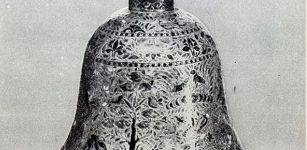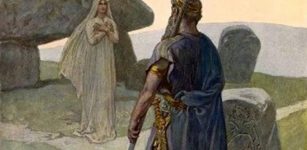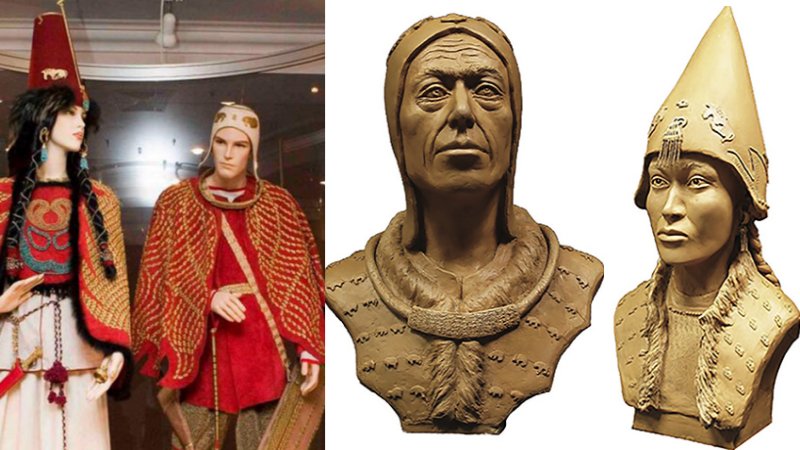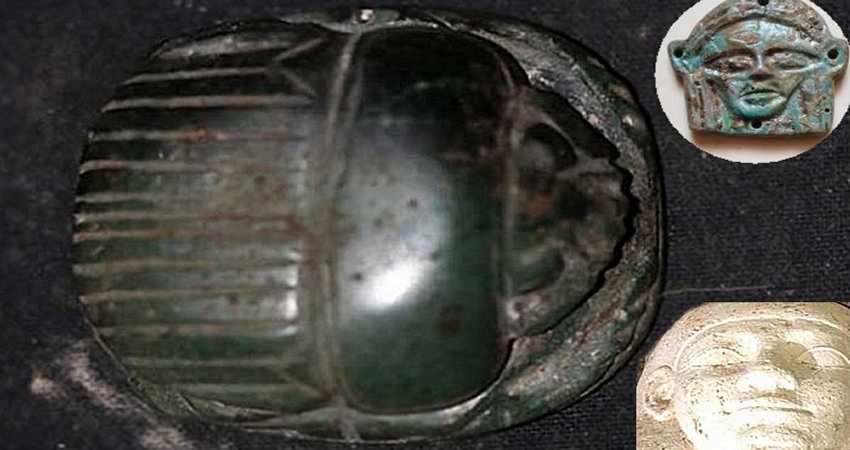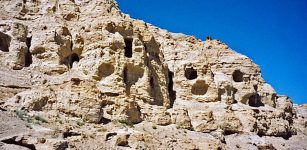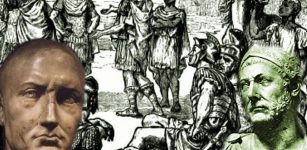The Controversial History Of Moses – Who Was He Really?
MessageToEagle.com – When people are spoken of constantly, we feel we know them. Christians and Jews have been talking about Moses for thousands of years, so they assume they know who he was. But is this an illusion?
Is it possible that no one really knows who Moses was? That the evidence about him is contradictory and enigmatic? Is it even possible that he never existed except in fable?
Even religious fundamentalists have an immediate problem with Moses, and the accounts of him in the biblical Book of Exodus. People who fanatically believe that every word written in the Bible or the Torah is somehow ‘the word of God’, ‘written by God’, or ‘inspired by God’ (these claims vary and are rarely defined with any degree of precision), are faced with serious contradictions in the biblical text itself.
Near the beginning of Exodus, God speaks to Moses from a burning bush at Mount Horeb in Sinai and tells him to go back to Egypt. So Moses, not wishing to be impolite to an unknown entity who has spoken to him from a burning bush in no uncertain terms, duly begins to travel to Egypt as instructed. But what happens next? Suddenly we are told in Exodus, Chapter 4, 24-27:
During the journey, while they were encamped for the night, the Lord met Moses, meaning to kill him, but Zipporah [the wife of Moses] picked up a sharp flint, cut off her son’s foreskin, and touched him with it, saying, “You are my blood-bridegroom.” So the Lord let Moses alone. Then she said, “Blood-bridegroom by circumcision.”
Can anybody explain what is going on? Here the supposed ‘Word of God’, i.e., the Bible, says the entity calling himself God instructs Moses to drop everything and rush off to Egypt, and then the same entity meets him on the way with the intention of killing him. This homicidal impulse is however appeased by Moses’s wife grabbing a sharp flint and circumcising her son and claiming that he is her bridegroom.
This all sounds more like an incident from a really bad Hollywood horror movie. And as for the actions of Zipporah, it is more like the kind of thing one might expect at a voodoo rite in Haiti than what one would expect from the wife of such a reputedly sober character as Moses, who is on a mission to Pharaoh to persuade him to “let My people go.”
As for “the Lord” so-called, he seems capricious at best and a homicidal maniac at worst.
There is no need for us to assume, as so many have uncritically done for millennia, that “the Lord” of Moses had anything whatever to do with God.
The world is full of paranoid schizophrenics who hear voices and believe that ‘God has spoken’ to them.
If all of these people were to be believed, there would be tens or hundreds of thousands of ‘Gods’.
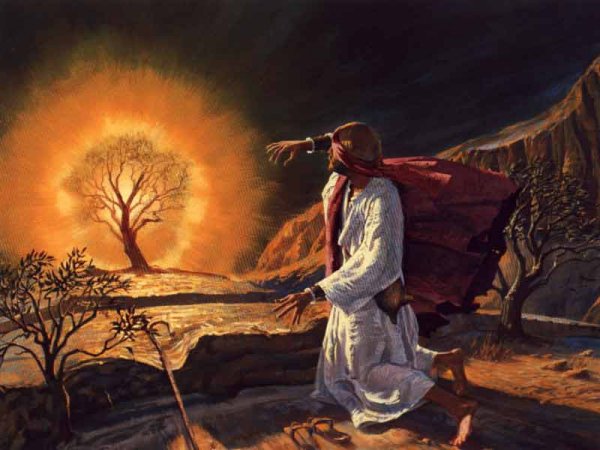
In order to try to figure out more about this puzzling episode from the Bible, I turned to a volume I have in my library which is a commentary on Exodus published by a biblical scholar named A.H. McNeile. He says:
The narrative in these three verses appears, from its contents, to be one of the oldest portions of the Bible. Its antiquity is shewn [sic] by the use of the flint knife, and by the part circumcision plays according to the belief of the actors.
McNeile then goes on to add that the text really says of the foreskin that she “made it touch his feet,” but he says that is a conventional euphemism of the time which really means touching her “pudenda,” i.e. her genitals.
If we are to believe this remarkable bit of information, we are faced with the undignified magical scene of the superstitious wife of Moses circumcising her son and pressing his bloody foreskin to her vagina and pronouncing him her bridegroom, or as McNeile translates her words: “A bridegroom of blood art thou, because of the circumcision.”
For some reason not explained at all, Yahweh is appeased by this and decides not to murder Moses after all. I ask any rational person: is such a Yahweh to be identified with ‘God’? Do all the people who attend church and synagogues seriously believe that ‘God’ wanted to murder Moses on his way to Egypt but was appeased by this tawdry bit of superstitious magic?
See also:
Long-Lost Play About Moses Discovered On Ancient Papyrus
The confusion over the true nature of Moses probably reached its most extreme form at Petra. Many tourists have now visited the amazing enclosed city of Petra in modern Jordan, which is reached by passing through a narrow crevasse in a cliff face. It is one of the surviving archaeological wonders of the world. Epiphanius of Salamis (who lived circa 310/320 CE – 403 CE) recorded in his book The Panarion, sometimes known as his book Against Heresies:
The profundities and glories of the sacred scripture, which are beyond human understanding, have confused many. The natives of Petra in Arabia [modern Jordan], which is called Rokom and Edom, were in awe of Moses because of his miracles, and at one time they made an image of him, and mistakenly undertook to worship it. They had no true cause for this, but in their ignorance their error drew an imaginary inference from something real
I wonder how many tourists going to Petra realise that they are going to the only place in the world where Moses was worshipped as a god. That’s not something you would be told by your tourist guide!
In the second century BCE, a Jewish playwright named Ezekiel lived at Alexandria in Egypt, and he wrote a drama in the Greek style called ‘The Exodus’, in which Moses was the leading character. This play survives only in extended fragments preserved by Eusebius (circa 263 CE – 339 CE) in his book The Preparation for the Gospel, which he took from an earlier historian named Alexander Polyhistor. The text of the play is largely lifted from the Bible, with flowery language and interpolations, as shown by this monologue by Moses:
Ha! See! What sign is this from yonder bush?
A marvel such as no man might believe.
A sudden mighty fire flames round the bush,
And yet its growth remains all green and fresh.
What then? I will go forward, and behold
This wondrous sign, that passes man’s belief.
From this, we can see that Ezekiel was no Shakespeare, and his task was a simple one, to dramatise the story of the Book of Exodus in a straightforward and rather unsubtle manner for the stage, so that the Gentiles of Alexandria could have the Jewish legends presented for them in an outdoor theatre. It was a bit like producing a soap opera for mass television, but it was two thousand years ago. One does not read anything about this play in the histories of the theatre, but it deserves a mention. It was probably much less corny than Cecil B. DeMille’s film about Jesus, ‘King of Kings’, which I had to sit through several times at the Roman Catholic school I attended as a child (an experience which helped put the finishing touches to my lack of affection for the Catholic Church).
The Staff into Snake into Staff Trick
Children who read the Bible always remember the vivid incident where Moses throws his staff on the ground before Pharaoh and it becomes a snake, and then he picks the snake up and it becomes a staff again. Actually, this is how we remember the tale but in fact the Bible says that Aaron, not Moses, does this before Pharaoh. In Exodus 4, “the Lord” and Moses have this dialogue:
Moses answered, “But they will never believe me or listen to me; they will say, ‘The Lord did not appear to you.’” The Lord said, “What have you there in your hand?” “A staff,” Moses answered. The Lord said, “Throw it on the ground.” Moses threw it down and it turned into a snake. He ran away from it, but the Lord said, “Put your hand out and seize it by the tail.” He did so and gripped it firmly, and it turned back into a staff in his hand. “This is to convince the people that the Lord the God of their forefathers, the God of Abraham, the God of Isaac, the God of Jacob, has appeared to you.” (4:1-6)
Later, the story of the snake continues in Book 7:
The Lord said to Moses and Aaron, “If Pharaoh demands some portent from you, then you, Moses, must say to Aaron, ‘Take your staff and throw it down in front of Pharaoh, and it will turn into a serpent.’” When Moses and Aaron came to Pharaoh, they did as the Lord had told them. Aaron threw down his staff in front of Pharaoh and his courtiers, and it turned into a serpent. At this, Pharaoh summoned the wise men and the sorcerers, and the Egyptian magicians too did the same thing by their spells. Every man threw his staff down, and each staff turned into a serpent; but Aaron’s staff swallowed up theirs. (7:8-13)
Even though this seems one of the most unbelievable stories in the Bible, it is curiously enough one of the most convincing (and hence, a source of encouragement regarding the veracity of some of Exodus), because this was a genuine trick of Egyptian magicians which was recreated in the twentieth century.
The way this trick is done is by means of ‘animal hypnosis’, or animal catalepsy. I described the use of the trick by Moses in my book Open to Suggestion, which was published in 1989. However, the book was only published in Britain, and readers in the USA never saw it. My book was an extremely long survey of worldwide hypnosis research, compiled by me over a period of 15 years. It also contained a survey of 150 years of documented case histories of the criminal abuses of hypnosis. My book so alarmed the hypnosis community and various security agencies (especially my sections on mind control and mass hypnosis), that every effort was made to suppress the book.
Eight American publishers to whom the book was submitted sent my agent identical letters from two referees (always the same two men in each case, whom I knew personally and strongly disliked) warning them that the book would be a public danger, and they must not publish it. The two referees were not distinguished clinicians or experimentalists, they were functionaries whose job it was to liaise between the security services and the hypnosis community.
They succeeded admirably in their task, which was to prevent the American public from ever reading such things as this revelation which I made: more than fifty percent of the hypnosis experiments carried out in the United States have been carried out by the government and are classified as top secret. You can understand why my book was considered seriously ‘uncool’ by various grim persons.
Dr. Franz Völgyesi & Animal Hypnotism
The man who perfected the ‘snake-into staff-into snake’ trick in the 1930s was one of the most extraordinary characters of his time, a Hungarian psychologist named Dr. Franz Völgyesi. I discussed him in my book, and that was especially unpopular, for reasons which will be clear in a moment.
In the 1930s, Völgyesi published a book in Hungarian entitled Ember és állat Hypnosis. I’m sorry I can’t translate that, for my Hungarian is rusty. This book appeared in a German translation in 1938, as Menschen- und Tierhypnose (Human and Animal Hypnosis).
The book was so shocking and astounding that it inevitably came to the attention of the Nazis. I have a copy of this rare book, an item that various interested parties would not like any members of the public to have.
Völgyesi became the hypnotist-in-chief to the Nazi regime, and considering that Hitler went into spontaneous auto-hypnotic trances nearly every day, it is more than likely that Völgyesi became Hitler’s personal, as well as official, hypnotist. (I have no evidence of that, and I am merely speculating, though I believe, soundly.)
Völgyesi was given carte blanche by the Nazis to carry out experiments on human beings. During the years between 1938 and 1945, he hypnotised no less than sixty thousand individuals, most of them Jews, Slavs, Gypsies, and leftists who were interned in the concentration camps. He could perform any experiments he liked, without reference to anyone. Considering the detailed evidence which we have of his experiments with dozens of animals, it takes little imagination to visualise what he would have done with sixty thousand human beings to play with.
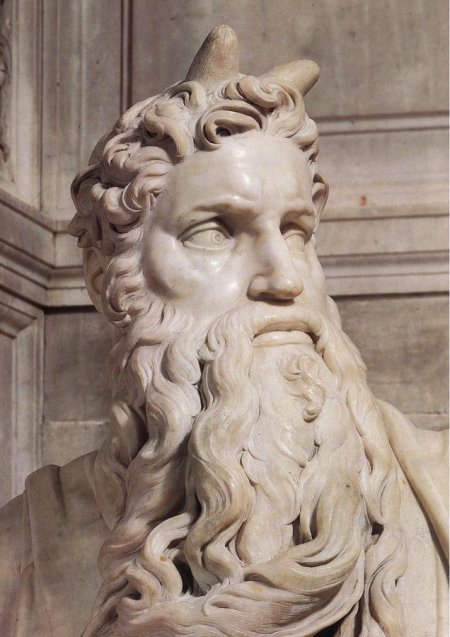
There is no doubt whatsoever that Franz Völgyesi was the most experienced hypnosis researcher in the entire history of the world. His research notes on these 60,000 cases ‘vanished’. But he himself did not vanish. He was one of those Germans snatched by the Americans, like Werner von Braun, and taken off to the United States, as a consultant to the security services. His research files probably exist somewhere in a high security archive of the American security services, ‘snatched’ at the end of the war. Someone should make an attempt to have them released through the Freedom of Information Act. I have ceased to pursue this subject, so I leave this task to others.
In 1963, Völgyesi was allowed to bring out a sanitised second edition of Menschen- und Tierhypnose, and in 1966 this appeared in London in an English translation as Hypnosis of Man and Animals.5 This time, the book appeared with his Hungarian first name of Ferenc rather than his German first name of Franz. (In America he was sometimes called Francis or Frank.) It is possible to purchase occasional copies of this book without too much difficulty.
In both books, Völgyesi published photos of cataleptic snakes which are stretched straight as rods, and have gone stiff. In the 1938 book, one is seen in Figure 8 on page 16. In the 1966 book, another one (an adder) is seen in Figure 18 in the first plates section. Völgyesi hypnotised just about every kind of animal, bird, or reptile you can possibly imagine. He would enter zoo cages and put bears and lions and crocodiles into trances with the greatest of ease. Many photos of these cataleptic animals are reproduced in his books. I cannot go into this fascinating subject further, and must return to Moses.
The fact is that any skilled animal cataleptist can turn a snake into a staff and a staff into a snake very easily. Such tricks were standard in ancient times. They were ways of calling attention to oneself as a wise man. And, frankly, if you couldn’t turn a snake into a staff no one would listen to you. So you might say Moses had little choice. And that is why I say that this incident is convincing evidence that there is genuine ancient material in Exodus, since later writers would not have been able to invent such a thing.
Moses’ Sacred Mountain
Moses is generally associated with Mount Sinai in the Sinai Peninsula. However, that is the wrong mountain. Although Mount Sinai was also important, it was Mount Horeb where Moses did most of his communing with his ‘Lord’, and where he saw the burning bush. But if you ask any biblical scholar where Mount Horeb is, they cannot tell you. It is officially unknown.
I am certain that it was the great mountain at Serabit in southwest Sinai. There is specific evidence to support this idea in the writings of Philo Judaeus (20 BCE – 50 CE), also known as Philo the Jew or Philo of Alexandria, where he lived and wrote. He wrote in Greek a lengthy ‘Life of Moses’, which survives in its entirety. Near the beginning of the third book of this treatise, Philo tells us:
For, having gone up into the loftiest and most sacred mountain in that district in accordance with the divine commands, a mountain which was very difficult of access and very hard to ascend, he is said to have remained there all that time without eating any of that food even which is necessary for life; and, as I said before, he descended again forty days afterwards, being much more beautiful in his face than when he went up, so that those who saw him wondered and were amazed, and could no longer endure to look upon him with their eyes, inasmuch as his countenance shone like the light of the sun.
Tourists often comment about how easy it is to ascend Mount Sinai, which goes completely against this evidence. On the other hand, the sacred mountain at Serabit in Sinai, much further south, which I believe to be the biblical Mount Horeb, is notoriously difficult to ascend. There is a great deal of crucial archaeological evidence about Serabit to support this hypothesis, but it is too lengthy and detailed to give here.
A magnificent ruined Temple of Hathor survives at the top, which dates from the Middle Kingdom period. It is known that the site was shared between the Jews and the Egyptians. Excavations have uncovered beneath the floor of the temple extremely thick layers of ash from offerings made on the mount before the temple was built, and it was admitted by Sir Flinders Petrie and other Egyptologists that this was clearly the famous ‘High Place of Burning’ of the early Jews before the time of the ‘Lord’ of Moses, who came to be known as Yahweh, and when the Jews still worshipped the deity or deities whom they called El, Elyon (the Canaanite form of the name), or Elohim (Elohim being a plural form of the name).
Apparently, during the period when Sinai was under Israeli occupation, General Moshe Dayan was so interested in Serabit that he had an entire Hathor column lifted out by helicopter and flown back to Israel, where he placed it in his private garden. That is not the correct way to behave! I hope that, since his death, it has at least gone to a museum somewhere.
I have elsewhere written about the associations of Moses and the early Jews with Serabit, and cannot repeat all of that here. I also have suggested that Jesus spent his forty days in ‘the wilderness’ at this same spot, in emulation of Moses, who spent forty days on this very mountain.
I think I should explain once again one other detail of the account in Exodus, which is the so-called ‘golden calf’. The explanation for this is that it was a Hathor-face, a wild cow’s face, and which to someone unfamiliar with Hathor traditions looks like the face of a calf. Philo specifically tells us that the misbehaving Jews who made the golden calf did so for this reason:
…they made a golden calf in imitation of the Egyptian worship and folly and established dances and prepared an altar…
As for the gold used to cast the golden calf (the Temple of Hathor must have been full of these), it is explained by the fact that Serabit was from Old Kingdom times a famous mining and metallurgical centre, where carvings of Pharaohs Cheops and Sneferu were engraved on the rocks. It was the main source of Egyptian copper for millennia. Gold was also processed and cast there, and the metallurgical workers were traditionally the Jews, who had a permanent settlement at the foot of the mountain. These Jews would have been respectful to Hathor because they were thoroughly Egyptianised. This was intolerable to the purist Moses, and with the aid of the Levites, he massacred 3,000 of them in the name of his ‘Lord’, YahwehThe only ‘calf’ worshipped by the Egyptians was the Hathor face, which looks like a calf to the uninitiated. Public dances were an integral part of Hathor worship at festival time, and were common at the Temple of Hathor at Denderah, so would have been common at Serabit as well. There were altars of Hathor at Serabit, and of course her huge temple, much of which remains, though it is never visited by tourists, and there is no road to it.
At other times he massacred other people, and so he was not a peaceful sort of fellow by any means. We don’t really know who he was, although he clearly was born in Egypt and grew up there. It is all very mysterious. But I, for one, am glad not to have met him, as he was not someone to mess with, and I would probably have said something sarcastic and been ‘massacred’. After all, Moses was into commandments. And some of us don’t like authority.
Written by: Robert Temple – New Dawn
This article has been republished with permission of New Dawn Magazine
Copyright © New Dawn If you appreciated this article, please consider a digital subscription to New Dawn.




